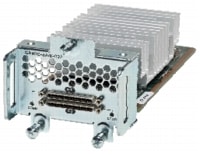The Cisco Channelized T1/E1 and ISDN PRI Rugged WAN interface card (GRWIC) modules are designed for use with the Cisco 2010 Connected Grid Router (CGR 2010). The Cisco Channelized T1/E1 and ISDN PRI Grid Router WAN Interface Cards (GRWICs) combine multiple T1/E1 WAN connectivity-Channelized T1/E1 and CISCO2821-SAA/K9 Primary Rate Interface (PRI) in the same card. Applications include fractional or full T1/E1 WAN connectivity, ISDN PRI for primary WAN link or WAN backup, and dial access aggregation. The Cisco CGR 2010 supports a one and a two-port version of the T1/E1 module in a single-wide GRWIC. The different versions help enable customers to deploy different port densities depending on wide area network needs in utility substation locations.
Figure . 1- and 2-Port Channelized T1/E1 and ISDN PRI Rugged WAN Interface Cards (GRWICs)

8-Port Asynchronous/Synchronous Grid Router WAN Interface Card
The 8-Port Asynchronous/Synchronous Grid Router WAN Interface Card (GRWIC) provides low speed synchronous/asynchronous serial connections supporting EIA-RS232 for the Cisco CGR 2010. The 8-port serial RS-232 GRWIC helps customers to enable applications such as legacy protocol transport, console server, and dial access server. Combining a high density serial GRWIC with the Cisco CGR 2010 enables utilities to transport Supervisory Control and Data Acquisition (SCADA) over an IP network
Figure . 8-port Asynchronous/Synchronous GRWIC

Customers have the option to install up to 4 GRWIC modules in the Cisco CGR 2010. CGR 2010 allows any combination of GRWIC modules to be populated in the 4 GRWIC slots on the router. The GRWIC SKUs in Table 10 below can be ordered with the router or as spares.









